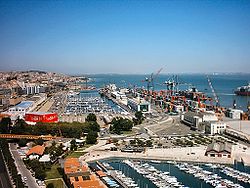
Back منطقة لشبونة Arabic Лісабонскі рэгіён Byelorussian Regió de Lisboa Catalan Região de Lisboa German Região de Lisboa DIQ Lisbona regiono Esperanto Región estadística de Lisboa Spanish Lisboa (eskualdea) Basque منطقه لیسبوا Persian Lissabonin alue Finnish
Lisbon
Região de Lisboa | |
|---|---|
 The port of Lisbon, the terminus of activities in the Region of Lisboa, that extends into Tagus estuary | |
| Etymology: Lisboa, Portuguese for Lisbon | |
 Location of the Lisbon Region in context of the national borders | |
| Country | |
| Capital | Lisbon |
| Area | |
• Total | 3,001.95 km2 (1,159.06 sq mi) |
| Population (2024) | |
• Total | 3,005,119[1] (2nd) |
| GDP | |
| • Total | €98.517 billion (2023) |
| • Per capita | €33,270 (2023) |
| Time zone | UTC+0 (WET) |
| • Summer (DST) | UTC+1 (WEST) |
| ISO 3166 code | PT-11 |
| NUTS | PT17 |
| Statistics from INE (2005); geographic detail from Instituto Geográfico Português (2010) | |
Lisbon Region (Portuguese: Região de Lisboa) is one of the seven NUTS II designated regions of Portugal, which coincides with the NUTS III subregion Lisbon Metropolitan Area. The region covers an area of 3001.95 km2 (the smallest region on mainland Portugal) [4] and includes a population of 3,005,119 inhabitants according to the 2024 estimates[1] (the second most populated region in Portugal after the Norte region),[5] a density of 1001 inhabitants/km2.
Considered as representing the Lisbon Metropolitan Region. It is a region of significant importance in industry (light and heavy), services, and it is highly urbanized. The gross domestic product (GDP) of the region was nearly 100 billion euros in 2023, accounting for 37% of Portugal's economic output. GDP per capita was at 33,300 euros or 87% of the EU27 average in the same year. The GDP per employee was 92% of the EU average.[6]
- ^ a b "População residente (N.º) por Local de residência (NUTS - 2024), Sexo e Grupo etário; Anual". INE. 18 June 2025. Retrieved 18 June 2024.
- ^ "Produto interno bruto (B.1*g) a preços correntes (Base 2021 - €) por Localização geográfica (NUTS - 2024); Anual". www.ine.pt. Retrieved 14 January 2025.
- ^ "Produto interno bruto (B.1*g) por habitante a preços correntes (Base 2021 - €) por Localização geográfica (NUTS - 2024); Anual". www.ine.pt. Retrieved 14 January 2025.
- ^ Statistical Yearbook of Portugal 2012. Instituto Nacional de Estatística. p. 50.
- ^ "Censos 2011 Resultados Preliminares 2011". INE.
- ^ "Regional GDP per capita ranged from 30% to 263% of the EU average in 2018". Eurostat.